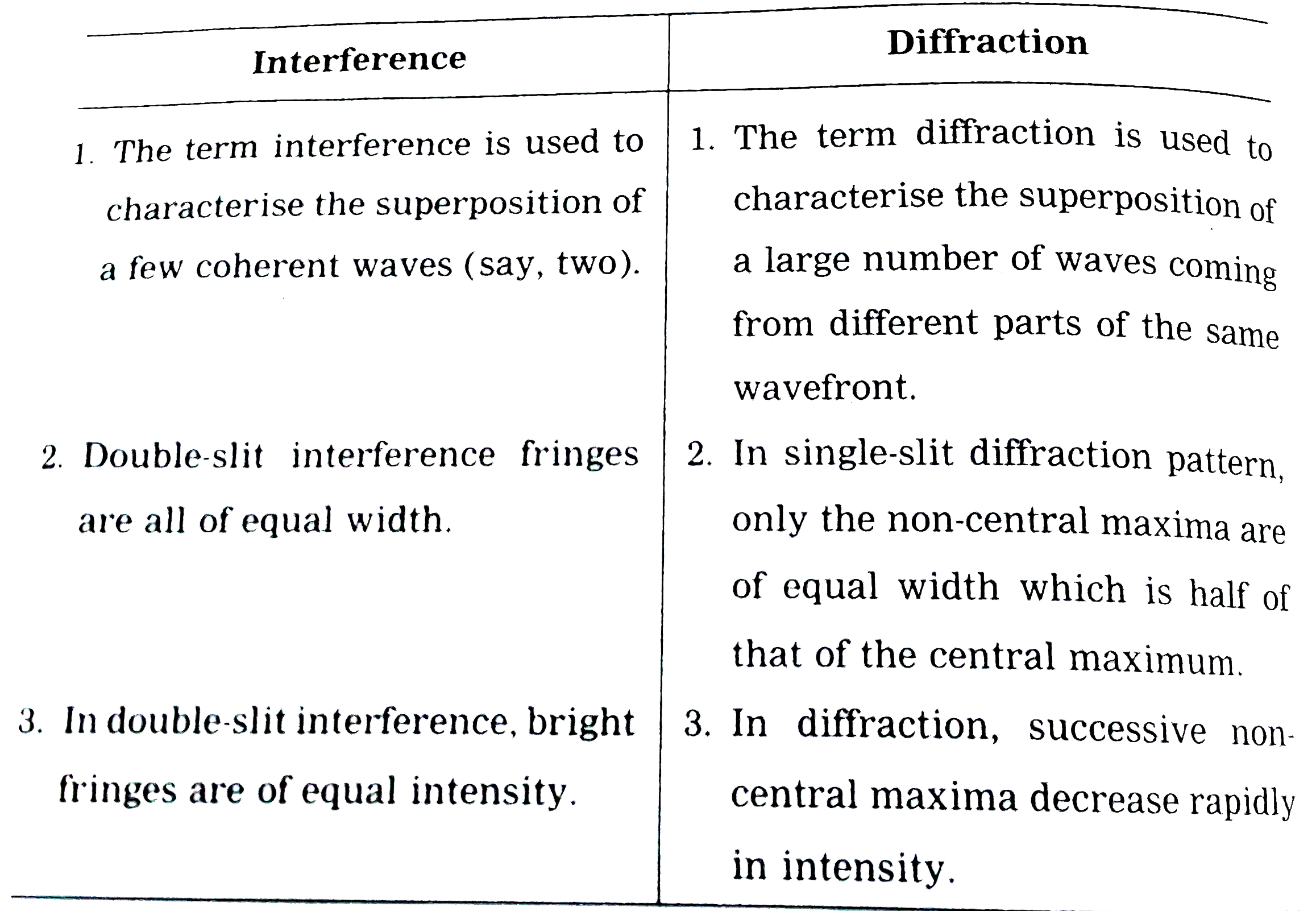Interference and Diffraction
Topper's Solved these Questions
- DISTINGUISH BETWEENBOOK - NAVNEET PUBLICATION - MAHARASHTRA BOARDCHAPTER - DISTINGUISH BETWEENEXERCISE - Magnetism
2 Videos
- DISTINGUISH BETWEENBOOK - NAVNEET PUBLICATION - MAHARASHTRA BOARDCHAPTER - DISTINGUISH BETWEENEXERCISE - Atoms, Molecules and Nuclei
1 Videos
- DISTINGUISH BETWEENBOOK - NAVNEET PUBLICATION - MAHARASHTRA BOARDCHAPTER - DISTINGUISH BETWEENEXERCISE - Stationary waves
3 Videos
- DERIVATIONS-IIBOOK - NAVNEET PUBLICATION - MAHARASHTRA BOARDCHAPTER - DERIVATIONS-IIEXERCISE - Assignments
9 Videos
- EXPERIMENTS AND DIAGRAMSBOOK - NAVNEET PUBLICATION - MAHARASHTRA BOARDCHAPTER - EXPERIMENTS AND DIAGRAMSEXERCISE - ATOMS, MOLECULES AND NUCLEI
1 Videos
Similar Questions
Both in interference and diffraction phenomena, alternate dark and bright fringes are obtained on screen
i) generally fringe width is same in interference and not same in diffraction
ii) the central fringe in interference has maximum brightness and thei intensity gradually decreases on either side
iii) in interference the intensity of all bright fringes in same
iv) both the phenomena are produced from same coherent sources
View SolutionDescribe any two characteristic feature which distiguish interference and diffraction phenomena. Derive the expression for the intensity at a point of the interference pattern in Young's double slit experiment.
(b) In the diffration due to single slit experiment, the aperture of the slit is 3 mm. If monochromatic light of wavelength 620 nm in incident normally on the slit, calculate the separation in between the first order minima and the 3rd order maxima on one side of the screen. The distance between the slit and the screen is 1.5 m.
View Solution
Knowledge Check
Assertion : Intensity pattern of interference and diffraction are not same.
Reason : When there are few sources of light, then the result is usually called interference but if there is a large number fo them, the word diffraction is more often used.AIf both assertion and reason are true and reason is the correct explanation of assertion.BIf both assertion and reason are true but reason is not the correct explanation of assertion.CIf assertion is true but reason is false.DIf both assertion and reason are false.This section contains Assertion and Reason type questions each question has 4 choices (1)(2)(3) and (4) out of which only one is correct
Assertion(A): In Young's double slit experiment often both the phenomenon interference and diffraction are present
Reason:diffraction results due to superposition of wavelets from different points of the some wavefrontABoth Assertion and Reason are correct and Reason is the correct explanation of the AssertionBBoth Assertion and Reason are correct but Reason is not the correct explanation of AssertionCAssertion is correct but Reason is incorrectDAssertion is incorrect but Reason is correctWhich of the following phenomena support the wave theory of light?
1. Scattering
2.Interference
3. Diffraction
4. Velocity of light in a denser medium is less than the velocity of light in the rare mediumA1, 2 and 3B1, 2 and 4C2, 3 and 4D1, 3 and 4
(i) Write two points to distinguish between interference and diffraction fringes.
(ii) In a Young 's double slit experiment , fringes are obtained on a screen placed at certain distance away from the slits . If the screen is moved by 5 cm towards the slits , the fringe width changes by 30 μm . Given that the slits are 1 mm apart , calculate the wavelength of the light used.
View SolutionWhich of the following relate to wave nature of light or particle nature or both ?
(a) Interference (b) Diffraction (c) Photoelectric effect (d) Black body radiation
(e) Planck's equation, E = hv (f) Einstein equation, E=mc2
View SolutionWhich of the following phenomenon proves the transverse nature of electromagnetic waves? (A) polarization (B) interference (C) diffraction (D) reflection
View SolutionWhich of the following is not characteristic of waves : Reflection, refraction, interference, diffraction, polarisation, rectilinear propagation ?
View SolutionInterference is
View Solution

